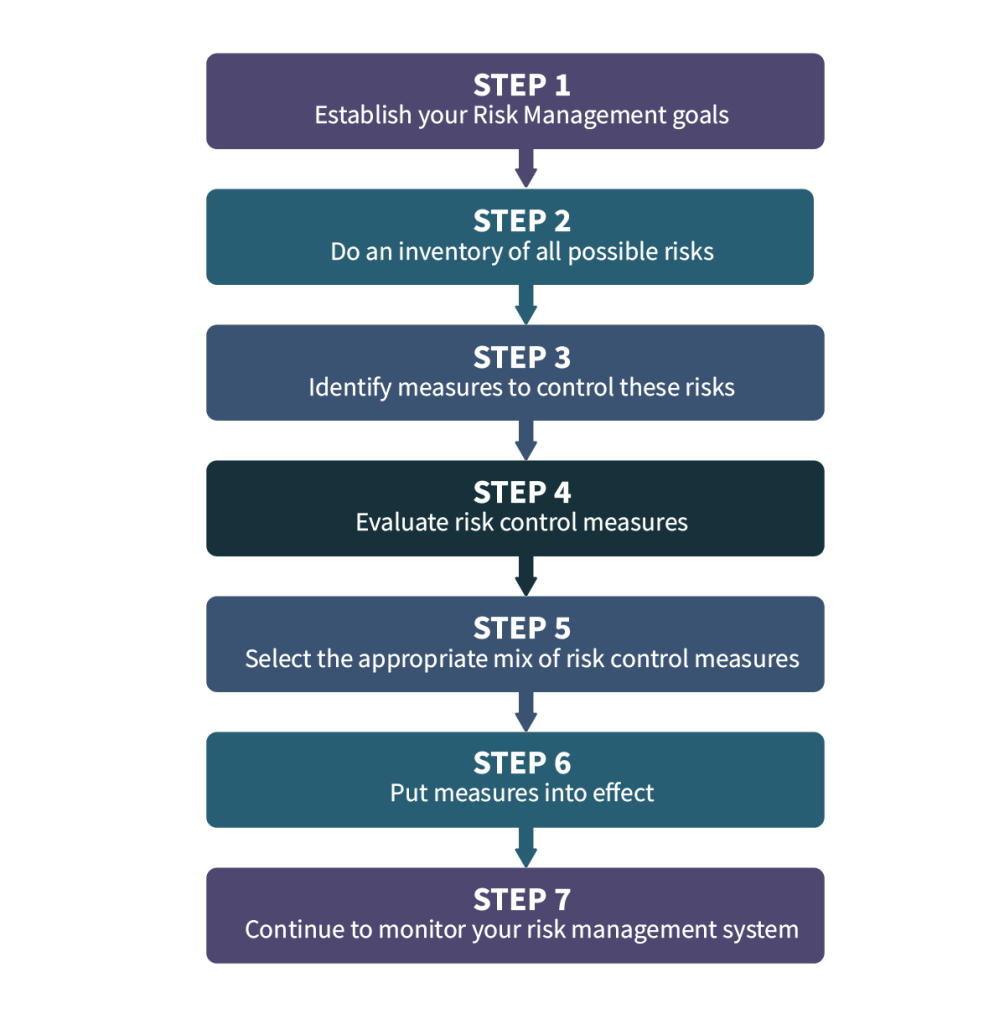8.4 Risk Management: A Planning Process
As a planning process, Risk Management includes all management, staff and volunteers of a specific agency, organization or business – not just the individuals who plan or lead activities. Although many risk-management standards are shared across the field and various sectors of the field, risk-management plans should be specific to the organization – you can’t borrow a plan from somewhere else – and need to be reviewed and updated regularly as standards evolve. Recreation professionals go through the following steps to ensure excellence in risk management, no matter how big or small the activity:

Image Description
Step 1. Establish your Risk Management goals
Step 2. Do an inventory of all possible risks
Step 3. Identify measures to control these risks
Step 4. Evaluate risk control measures in light of:
-
- The magnitude of the risk (see the Frequency × Severity Matrix)
- Standard of care expected
- Available resources on hand
Step 5. Select the appropriate mix of risk control measures
Step 6. Put measures into effect
Step 7. Continue to monitor your risk management system
Policies and Procedures
Recreation organizations, agencies, facilities and businesses have established policies and procedures for employees to follow in the event of an emergency or unusual situation.
Policies: Give direction to how an Agency operates and are an integral part of the Risk-Management process. Policies are published guidelines that govern the behaviour and actions of employees and volunteers so that they are consistent with the philosophy, values, goals and objectives of the Agency. Although policies tend to be broad in scope and application, they help reduce unfavourable events (accidents, disasters) from occurring by providing guidelines for conduct.
Procedures: Specific actions or approved steps required to carry out Agency policies. While policies tend to be broad in scope, procedures are more specific.
Types of Procedures
When something is injured on your watch, whether it be at the ice rink, on the ski hill, in a gymnasium, or in the yoga studio, if that individual shows up an hour after being injured and says, “Show me what it is you have written down to prevent accidents like mine from happening. Show me what you were supposed to have done before and during my accident. Show me the part that explains and justifies why you acted or reacted the way you did”. You need to be able to pull out the Procedures Manual in some form – hardcopy or digital – and show them. Written Policies and Procedures act as a roadmap and guide for preparing for risk, planning for risk, managing risk and reviewing risk management processes. Policies and Procedures are not static but malleable. Policies need to reflect reality, and so they tend to change and get updated frequently, according to the law and current trends in the industry.
1 – Operational Procedures (aka Standard Operating Procedures or “SOPs”)
- Correct use of an A-Frame ladder
- How to book the gymnasium
- How to write and file an incident report
- How to safety inspect a high-angle environment (ropes course) site prior to use
2 – Emergency Procedures (What to do in the event of an emergency)
- What to do if a participant experiences a medical event during program
- What to do if a physical fight breaks out between 2 participants
- What to do in the event of a missing person
- What to do if a trespasser/unwelcome person is detected in the facility
![]()
Terms to Learn
Duty of Care: The obligation one person owes to another based on a legal relationship between that individual and the other. A Duty of Care is a legal obligation imposed on an individual – an “occupier” – the person in legal possession of a property (ie; a Recreation Agency or a Community Centre) who has control over, and responsibility for, the condition of the property. A Duty of Care requires the occupier(s)’ adherence to a standard of reasonable care to avoid careless acts that could foreseeably harm others and lead to a claim of negligence.
For example: By purchasing a gym membership, you have entered into a legally binding relationship – they owe you a duty of care. In recreation, the leader /instructor has an obligation to provide reasonably hazard-free activities and facilities.
Breaching a Duty: When an occupier fails to meet reasonable standards for a duty of care.
Inherent Risks: Risks that are generally associated with and considered to be an unavoidable or natural part of a particular activity.
In Loco Parentis: Latin, meaning “in place of the parent.” Recreation professionals are very often “in loco parentis” in that they are expected to pay the same duty of care to protect the safety and well-being of the children in their care as the parent might.
Negligence: Failure to use reasonable care, resulting in damage or injury to another or another’s property.
Malfeasance: Serious wrongdoing, often illegal. Malfeasance is an act with malicious intent to hurt, cause harm, or otherwise injure or cause injury to another party through misconduct or an abuse of power. Malfeasance is the worst kind of negligence and is also called gross negligence.
Policies: Give direction to how an Agency operates and are an integral part of the risk management process. Policies are published guidelines that govern the behaviour and actions of employees and volunteers so that they are consistent with the philosophy, values, goals and objectives of the Agency.
Procedures: Specific actions or approved steps required to carry out Agency policies. While policies tend to be broad in scope, procedures are more specific.

